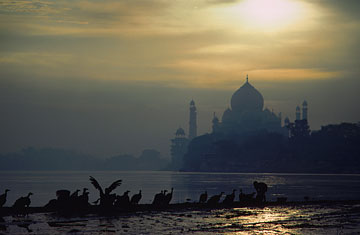
Vultures scavenge human remains left at the burning ghats on the banks of a river in Agra, India
For the small number of vulture lovers the world over, good news comes this summer from Sindh, Pakistan. In June, a new "vulture restaurant" opened to provide safe food for the endangered birds — no reservations needed, but it's always a fierce fight for the flesh. Similar vulture ventures have already been successful in South Africa, India and Nepal, where one region in which a restaurant started to provide vultures with clean carcasses saw a doubling of nesting pairs in just two years, according to Bird Conservation Nepal.
Alas, uplifting news is rare in the vulture world: the big picture is that the birds, commonly portrayed as harbingers of death, are themselves facing doom, particularly in the eastern hemisphere. Three species in South and Southeast Asia were placed on the International Union for Conservation of Nature's critically endangered list 10 years ago — to little effect. The oriental white-backed vulture population has declined a catastrophic 99.9% in the past 15 years; once estimated at 40 million, the global number now sits below 11,000. The long-billed and the slender-billed vulture populations have also fallen nearly 97%, according to a 2007 study published in the Journal of the Bombay Natural History Society.
Though the West's vulture populations have not been hit as hard, the case of the quickly disappearing vultures is an alarming example of how difficult it can be for animals to find their place in our modern world. The advent of 20th century farming replaced wild herd animals, whose carcasses are the staple diet of vultures around the world, with heavily medicated livestock. Diclofenac, a frequently administered anti-inflammatory veterinary painkiller comparable to ibuprofen, has proven to be particularly deadly to the vultures that ingest it secondhand. Though the birds by design have "very strong stomach fluids" that digest even the nastiest of pathogens, this particular drug has proven too much, says Tom Aversa of Seattle's Woodland Park Zoo. After populations' decreasing numbers were first noted in the 1980s, it was found that diclofenac residue in livestock carcasses was causing kidney failure and visceral gout in the birds.
Vulture restaurants may be the birds' best immediate hope. At the Sindh facility, veterinary staffers are trained to inspect and purchase safe meat, usually from cattle and goats, from local farmers. Some vulture restaurants in India also allow meat drop-offs, making it easier for farmers to dispose of carcasses. Though most restaurants are operating in Asia, there are also a few others in Africa. Anywhere from five to 100 vultures may descend in a day at South Africa's Camp Jambulani vulture restaurant, ranger Steven DuToit tells TIME.
Unfortunately, finding a wholesome meal isn't vultures' only problem these days. Their natural habitat of wooded areas is continually being encroached upon as more trees are being cut down to make way for villages and cities, and the endangered vultures can be injured in aircraft collisions. And that's not only bad news for the birds. Countries where vultures are most threatened, such as Nepal, India and Pakistan, rely heavily on vultures for a kind of natural maid service: as they clear out dead animals, the risk of disease is also reduced. Dangerous wild-dog packs that feed on dead livestock have also flourished without competition from the birds, says Todd Katzner of Pittsburgh's National Aviary, leading to a new surge of rabies, particularly in Mumbai. "People don't realize what a key role vultures play in the ecosystem," says Aversa. "[They] prevent disease and recycle."
Though the Indian and Nepalese governments banned diclofenac five years ago after its fatal effect on vultures was discovered in a 2004 study led by the Peregrine Fund, manufacturers like Pakistan's Star Labs and Brazil's Ouro Fino continue to push the drug in Africa, where vultures are likely to suffer the same fate as their Asian counterparts, says Chris Bowden of the Royal Society for the Protection of Birds. North America's turkey vultures don't seem as susceptible, however, reports a 2008 study in Environmental Toxicology and Chemistry. The continent's growing number of 25 million turkey and black vultures don't yet show significant signs of decline.
On Sept. 5 — the first annual International Vulture Awareness Day — zoos and bird societies around the globe will sponsor educational tours and flight demonstrations to get the word out about the plight of the vultures. Unlike blue whales, polar bears and other beloved species in danger of extinction, it may be harder to rally folks to save these prickly feathered birds with bumpy, bald heads, portly physiques and a tendency to be knee-deep in rotting flesh. "People look at vultures and see an ugly bird," Aversa says. "We will try to change attitudes and raise awareness of these scavengers in the ecosystem."
And vultures — despite their morbid reputation — will certainly respond warmly to human assistance. As the vulture barbershop quartet sings to Mowgli in Disney's The Jungle Book, "We're your friends to the bitter ends ... Who's always eager to extend a friendly claw?"
